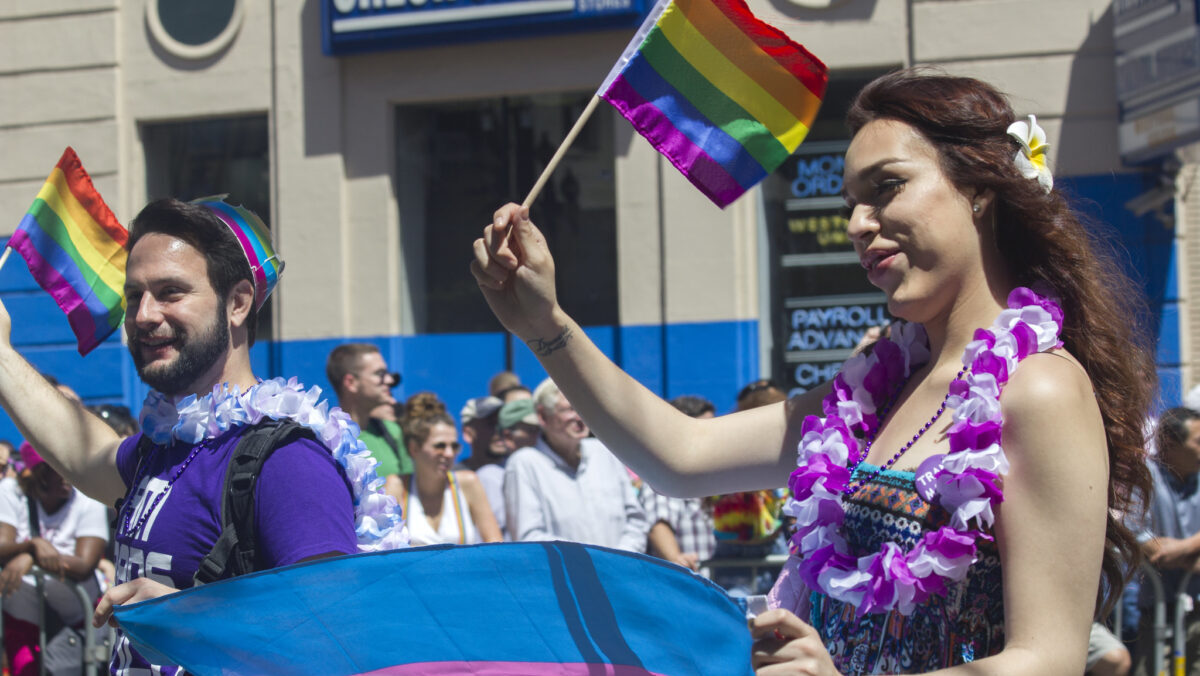3 Ways Feminism Laid The Groundwork For Transgenderism

The trans movement is in full bloom. Many are scratching their heads as to how we got here.
A survey of the last two centuries reveals that it was long in the making, with deep roots found in feminist ideology, as discussed at length in my book, The End of Woman. Feminism ushered in significant shifts in thinking about women, fundamentally changing the way Western civilization considers biology, language, and law.
Each of these shifts on its own would have been damaging enough, but like the poisonous tentacles of a jellyfish, when taken together, they were fatal and brought about the triumph of the LGBT movement.
Biological Argument: Make Women More Like Men
One of the earliest efforts of the feminist movement was to help women with the suffering associated with fertility. It is a laudable goal, except that rather than help women as women, the feminist vision was to help women become more like men, namely, rendering their bodies sterile to enable sex without consequences.
The idea was to get rid of the connection between women and motherhood. Among first-wave activists, Elizabeth Cady Stanton said, “The woman is uniformly sacrificed to the wife and mother.” A few decades later, Charlotte Perkins Gilman said motherhood made it “impossible for women to achieve their potential.” And by the 1960s, Betty Friedan completed the transformation by famously encouraging every woman to leave the “comfortable concentration camp” that is the home to do productive work. The message was clear: Career is more important than motherhood.
The biological transformation away from motherhood would not have been possible without the work of Margaret Sanger, promoter of birth control and founder of Planned Parenthood, who envisioned a eugenic utopia where individual pleasure triumphed over the family. Women, she believed, were the source of “the most flagrant of our social evils” because of their fecundity, and as a result, women had not only “incurred a debt to society” but must “pay that debt” by not having more children.
With the Pill and later Roe v. Wade, women could finally live the ideal of consequence-free sex by eliminating their reproductive capacities entirely. Birth control was the prophylactic, and abortion was its backup safety net.
Erasing this essential element of women, the capacity to conceive and bear life — biologically, psychologically, and spiritually — quickly made the meaning of woman murky. For women, motherhood was largely erased as an essential and replaced with a vision of womanhood modeled after a masculine ideal. To maintain this new ideal for women — the pursuit of a career — women were sold the rabid dependence on contraception and abortion that we see today. It can be argued that feminism has been transitioning women into men for decades, with few noticing because of the enticing idols of achievement and independence.
Language Change: Implementing the Sexless Language of ‘Human Person’
While feminism was pushing women to be like men, a second societal change developed: a subtle change in language. What seemed minor was, in fact, a significant change in the way men and women viewed human nature. It started harmlessly enough, with Mary Wollstonecraft emphasizing the common dignity and rationality of all human beings to distinguish women from slaves and cattle. This focus on what is common between men and women quickly undermined what distinguished them, such as the centrality of motherhood. Feminists, seeing the utility of this linguistic emphasis, have used it repeatedly ever since. Consider the following examples:
In the late 1800s, Susan B. Anthony: “The only question left to be settled now is: Are women persons? And I hardly believe any of our opponents will have the hardihood to say they are not.”
In the 1910s, Marie Jenney Howe: Feminism was a quest for women to become “not just our little female selves, but our whole, big, human selves.”
In the 1940s, Elizabeth Hawes: “Females, as well as males, are human beings.”
In the 1960s, Betty Friedan: “Perhaps it is only a sick or immature society that chooses to make women ‘housewives,’ not people.”
And in 1986 Marie Shear: “Feminism is the radical notion that women are people.”
Curiously, no one was denying the humanity of women at this stage, particularly in cultures animated by Christian ideals. It was more of a straw-man argument adopted to eradicate the differences between males and females. Once those differences were eliminated in general at the altar of the common, motherhood was sacrificed as unimportant. This was a decided break from the Judeo-Christian vision that had always included both the common and the distinct understanding of man and woman built upon Genesis 1:27: “God created man in his own image, in the image of God he created him; male and female he created them.” Feminism emphasized the commonness of male and female at the expense of the essential ways in which men and women were distinct.
This designation did more than just separate women from the quality of motherhood. It created a category of embodied existence entirely distinct from male or female. The human person became a blank canvas on which other ways of being could exist, opening the door to the idea of genderless or differently gendered human beings.
This concept of the human being might not have proven so problematic if there were not also a push in the feminist movement to erase so-called gender altogether. As early as the 1800s, Percy B. Shelley, who promoted a “women’s revolution,” presciently suggested that society would one day eliminate the “detestable distinction” of sex differences. Future feminists followed his lead.
“Gender” tinkering came to a head in 1949 with Simone de Beauvoir’s statement: “One is not born, but rather becomes a woman.” Her idea was that the attainment of womanhood was no longer exclusive to those born female. Womanhood was simply a social construct and could, therefore, also be deconstructed. De Beauvoir’s existentialist vision of personal actualization and authenticity allowed womanhood to become an abstract state of mind, not a concrete way of being. With womanhood no longer limited to just biological women, feminism opened Pandora’s Box to today’s endless “gender” confusion and creation.
Legal Change: Civil Rights Fight
Feminists developed a political playbook for women’s voting rights that, once refined in the 1960s, became masterfully exploited by gay activists. After the Civil War and the newly granted right of freed slaves to vote, Elizabeth Cady Stanton compared the plight of black men with a woman’s right to vote. Cady Stanton saw the 15th Amendment as an opportunity to finally get the vote for women, although she lamented that the men she thought beneath her had a right she did not have: “Think of Patrick and Sambo and Hans and Yung Tung, who do not know the difference between a monarchy and a republic, who cannot read the Declaration of Independence or Webster’s spelling book, making laws for Lucretia Mott.”
If not for Stanton’s rampant racism and resulting internal squabbles and scandals within the suffrage movement, the strategy might likely have won the day. (She was long dead when the 19th Amendment finally passed in 1920.) When the civil rights debate reignited as African Americans fought for the end to segregation in the 1960s, feminists again attached themselves to the public fight as other victimized minorities. Thus was born the still-common phrase “women and other minorities.”
This “victimized minority” category is exactly what gay activist Franklin Kameny recognized as the key to advancing so-called gay rights, so he rebranded homosexuality as “an oppressed cultural minority.”
Kameny developed the slogan “Gay is good,” fashioned after the popular 1968 chant, “Black is beautiful.” He helped found the gay activist organization the Mattachine Society, which focused on repealing sodomy laws. Kameny also invited the lesbian group Daughters of Bilitis to join his effort, to move the debate and focus away from male sexual promiscuity. His goal was to normalize homosexuality and make it appear equal to heterosexuality. Before this, homosexuals had generally eschewed the heterosexual lifestyle and saw flamboyance and decadence as the way to banish the bourgeois and smash cultural taboos. Kameny’s more pedestrian vision has been wildly successful, culminating in the 2016 Supreme Court approval of gay marriage.
Kameny’s effort was also deeply aided by the societal changes taking place because of the feminist push for contraception and abortion, mentioned above. The arrival of the Pill and other modes of birth control slowly but steadily changed heterosexuals’ view of sex. There was a massive psychological shift away from viewing reproduction as the primary purpose of sexual activity to focusing solely on sex for personal pleasure. This move made it intellectually difficult for heterosexual couples who used contraception to fundamentally distinguish their relationship from that of a homosexual union. Both, albeit for different reasons, were sterile.
These three essential changes in biology, language, and law have devastated the Judeo-Christian vision of society, family, men, and women. They created the understanding of sexuality our culture embraces today, where sex differences are as essentially nonconsequential as black and white (or pink and blue). Together, these changes have made the human body a blank canvas onto which a whole rainbow of colors can be applied, none of which would have been possible without feminists leading the way.
Carrie Gress is a fellow at Ethics and Public Policy Center. A mother of five, she is the author of 10 books, including “The Anti-Mary Exposed: Rescuing the Culture from Toxic Femininity." She is the editor of the online women's magazine Theology of Home. Her latest book is "The End of Woman: How Smashing the Patriarchy Has Destroyed Us."





















